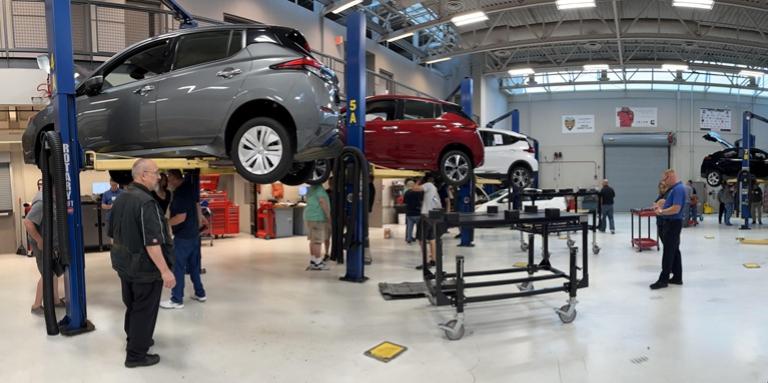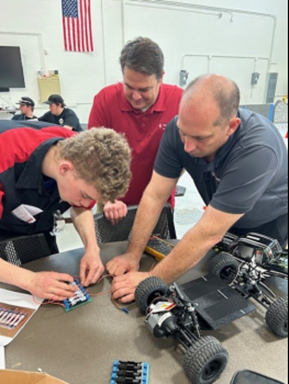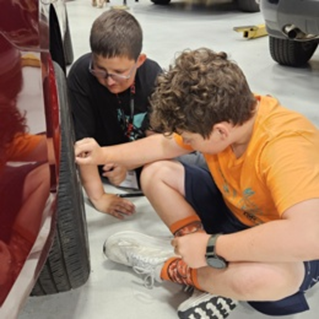Sinclair Community College Automotive Technology Department: A Case Study of Leadership

"Find the need and endeavor to meet it" is the seminal quote from David A. Sinclair, Director of YMCA of Dayton, later named Sinclair Community College, from 1887 to 1902. This powerful message still serves as a mantra for the institution’s faculty and staff. The original mission of D. A. Sinclair and the YMCA was to support the Dayton community by providing services such as adult education courses and job training (YMCA of Greater Dayton, n.d.). Subsequently, due to the proliferation of automobiles in the late 1800s to early 1900s, an automotive technology curriculum was developed by the YMCA in 1904; in 1906, what would become Sinclair Community College's Automotive Technology Department offered its first courses in automotive repair (Borg, 2007). As Greenhouse (2009) affirmed in a New York Times article, the college served the community by putting effort into developing a capable workforce to serve Dayton and surrounding areas. This mission has not wavered over the past 120 years.
Vocational Education: Empowerment Through Identity
In 2015, during the initial welcome and remarks at a symposium for developing postsecondary transfer modules, the plenary speaker vehemently and repeatedly forbade the audience from using the term “vocational education” because of its perceived negative connotations (Tucker, 2015). The speaker stressed the importance of replacing vocational education with “career-technical education,” as if this shift would uplift the students in the eyes of higher education and society at large. Contrary to this line of thought, Rehm (1990) deconstructed the term “vocation” in an historical context to shed light on the true nature of the term:
A vocation from its very beginnings has indicated a unifying project for one's life that inspires certain actions and a great variety of skills and consequences . . . There is no guarantee that manifest success will occur with every trial, but the individual learns and gains wider understanding of meanings of life. Regardless of the idiosyncrasies that befall, a vocation is a guiding force to find the truth of the work of the self in relation to personality as well as to others. (p. 119)
Kovan and Dirkx (2003) further asserted that vocation is an active process that fosters the ability of the individual to make meaning of their lives through a continuous discipline of learning that involves both "outer work" and "inner work" (p. 101). Additionally, Billett (2020) ascribed the importance of effective vocational status primarily based on supported curriculum and pedagogical practices. Nelsen (1997) explored the significance of symbols present in the automotive repair industry, contending that to be respected in the automotive field, the technician must create an "occupational image" that symbolizes "competence, professionalism, and membership in the community of practice" (p. 78).
Sinclair's automotive program continues to embrace the idea of vocational education and the holistic implications for fostering student development and critical thinking skills, thereby increasing the professionalism and competence of today’s modern automotive technician and putting graduates on a path to high-tech/high paying careers.
Leadership in Vocational Education Today
Sinclair was recently ranked number one out of 711 colleges in the United States for providing vocational training programs (Real Work Matters, 2020). This status is due to multiple factors. Wergin (2003) described a high-quality academic department as one that develops a collective vision, listens carefully to the interests of stakeholders but holds to its values, nurtures and supports experimentation, and acts in ways that connect faculty and stakeholders. For many of the automotive department's large-scale projects, a blend of team leadership models is used to approach complex tasks in a manageable way. Bouwmans et al. (2017) contended that distributed leadership in teacher teams depends on structures such as the organizational culture and values and the actions and interactions of those involved. He notes that distributed leadership in teacher teams "is preferable during complex educational innovations . . . if teams are to cope more effectively with these innovations” (p. 556). Intimately related is the theory of collaborative leadership developed by Chrislip and Larson (1994), who stated, "If you bring the appropriate people together in constructive ways with good information, they will create authentic visions and strategies for addressing the shared concerns of the organization or community" (p. 269). To best serve the community, industry, and other stakeholders' needs, all faculty members and the department chair teach courses and participate in collegewide leadership activities, including strategic outreach; the Women in Science, Technology, Engineering Mathematics institute; high-school outreach; and workforce development boot camps.
Connecting the Workforce to Industry
Since its first corporate-sponsored internship program in 1982, the automotive department has developed a reputation for providing capable automotive intern technicians to Dayton and surrounding areas through four cohort-based, manufacturer-supported internship programs. The success of the internship cohort model is undergirded by a philosophy of teaching students how to learn and adapt. While focusing on the rigorous application of fundamentals, the curriculum constantly progresses to meet the needs of an ever-evolving industry. This is possible in part by developing partnerships with companies like General Motors, Stellantis, Honda, Nissan, Volkswagen, Rivian, and Tesla to identify industry training needs and curriculum development. Furthermore, by providing release time for internship/industry coordinators, the automotive department can give individualized attention to independent repair facilities and new car dealerships. Distributing the leadership duties between multiple internship coordinators increases the success of the long-term internships by continuously communicating with stakeholders such as interns, mentors, dealerships, and corporate sponsors through activities such as advisory committee meetings and physical site visits.


Left image: Sinclair professors build radio control car battery packs at a Junior Career Exploration Day. Right image: Students learn how to change a flat tire at the annual Automotive Summer Camp.
Staying Ahead of the Curve
Electric vehicle technology has existed as long as Sinclair Community College and was popular with commuters in the late 1800s to early 1900s. However, historical factors, including WWI, created a substantial demand for fossil fuels and effectively suppressed this technology for almost a century. In 1997, the EV1 was piloted by General Motors (GM) and was the first domestic electric vehicle with an acceptable charge time and range presented to the public. Later that year, because of a long-standing relationship with GM, an EV1 was brought to Sinclair's automotive department for a demonstration for faculty, staff, and students. Although the EV1 never made it to the public, it raised awareness of the need to develop an understanding of electric powertrains, and just two years later, the Honda Insight, followed by the Toyota Prius in 2000, introduced the United States to an alternative to both electric vehicles and gasoline vehicles by developing hybrid vehicle technology. The automotive department immediately started investigating this new technology and determined that grant funding could potentially be leveraged to fund the tools, equipment, and vehicles necessary to stay on the cutting edge.
Starting in 2006, Sinclair began working with the National Science Foundation's (NSF) Advanced Technical Education (ATE) grants system to provide funding for exploring advanced automotive technology and curriculum development. With a total of five grants through NSF and Electrify America, Sinclair has created an internationally recognized curriculum, including hybrid/advanced hybrid vehicle systems, advanced driver assistance systems (ADAS), and battery electric vehicle (BEV) technology. Furthermore, splitting the duties of Principal Investigator (PI) between four faculty members allowed the department to develop individual expertise and made it easier to teach other faculty and PIs due to the discourse resulting from individual exploration. This type of leadership structure has proven to increase individual and diverse expertise throughout the department and guarantee the mission's perseverance by preparing junior faculty to take on future grant responsibilities.
Through substantial government loans from the Department of Energy, the Tesla Model 3, Nissan Leaf, and Chevy Volt were introduced to the market by 2010. Unsurprisingly, Sinclair's automotive department had amassed the tools, essential equipment, and broad content knowledge needed to jump-start the next six years of grant work through NSF/ATE. Furthermore, as part of the grants, the automotive department must disseminate its findings to the community. This is accomplished through community discussions, speaking engagements, and distribution of curricula to other schools. Most importantly, the department created annual week-long summer institutes which are attended by automotive technology faculty. Historically, the primary goals of the ATE grants were to increase the content knowledge of participating college instructors and to provide a foundation for a more informed teaching community regarding advanced technology such as Hybrid, BEV, and ADAS. However, the automotive department has recently focused on providing coaching to assist instructors in presenting advanced technology by deconstructing our experiential learning activities and demonstrating step-by-step techniques to create easily repeatable and assessable lab activities using emerging technology and the application of the latest tools and techniques. Subsequently, many of the instructors have launched their own ATE grants using materials they gathered from the original Sinclair grant projects.
A Department Reaching Beyond the Institution
To further bridge knowledge gaps in industry, Mason (2002) encouraged short duration continuing education and training for adults of all ages without undermining current efforts to reform and improve apprenticeship training. In 2023, Sinclair was awarded the Electrify America STEM grant to implement a training course to provide workforce development to incumbent workers at independently owned repair shops and new car dealerships. Sinclair's automotive technology department was one of five entities in the nation to split a $1.6 million investment in electric vehicle infrastructure. Furthermore, to prepare the next generation of qualified automotive technicians, NSF and Electrify America have supported recruitment efforts by funding summer camps for seventh to ninth graders and career exploration visits for eleventh and twelfth graders to bolster future enrollment in automotive programs. Community outreach is not a new concept for Sinclair's automotive department, as it has continually collaborated with the Miami Valley Tech Prep Consortium for over 25 years, providing opportunities for career tech students to leverage their content knowledge for college-level credit. As a result, automotive CTE students have earned over 2,500 Sinclair automotive credit hours over the last five years.
Funding from federal, state, and local levels is critical in developing a current and cutting-edge curriculum. Developing this curriculum in-house requires significant amounts of vehicle components; entire vehicles; and hundreds of hours to deconstruct, study, and package a curriculum customized for various types of learners. Grants like this help reduce the costs of programs like automotive tech by providing additional funding for equipment and tools as well as training and compensation for additional hours of program development.
By creating a model of leadership that focuses on collaboration, rationality, and pragmatism, Sinclair’s automotive department has placed itself at the center of advanced technology. When every member of the faculty looks for opportunities to elevate the knowledge, skills, and abilities of their students, incumbent workers, high school students, high school instructors, and college instructors, it is almost impossible to stop, or even slow, the momentum they have created.
References
Billett, S. (2020). Perspectives on enhancing the standing of vocational education and the occupations it serves. Journal of Vocational Education & Training, 72(2), 161-169. https://doi.org/10.1080/13636820.2020.1749483
Borg, K. L. (2007). Auto mechanics: Technology and expertise in twentieth-century America (pp. 1-249). JHU Press.
Bouwmans, M., Runhaar, P., Wesselink, R., & Mulder, M. (2017). Towards distributed leadership in vocational education and training schools: The interplay between formal leaders and team members. Educational Management Administration & Leadership. https://journals.sagepub.com/doi/pdf/10.1177/1741143217745877
Chrislip, D. D., & Larson, C. E. (1994). Collaborative leadership. Jossey-Bass.
Greenhouse, S. (2009, August 14). At Sinclair Community College, focus is jobs. The New York Times.
Kovan, J. T., & Dirkx, J. M. (2003). "Being called awake": The role of transformative learning in the lives of environmental activists. Adult Education Quarterly, 53(2), 99-118.
Mason, G. (2020). Higher education, initial vocational education and training and continuing education and training: where should the balance lie? Journal of Education and Work, 33(7-8), 468-490.
Nelsen, B. J. (1997). Should social skills be in the vocational curriculum? Evidence from the automotive repair field. In A. Lesgold, M. J. Feuer, & A. Black (Eds.), Transitions in work and learning: Implications for assessment (pp. 62-88). National Academy Press.
Real Work Matters. (2020). Trade schools in Ohio. https://www.rwm.org/states/ohio-trade-schools
Rehm, M. (1990). Vocation as personal calling: A question for education. Journal of Educational Thought (JET)/Revue de la Pensée Educative, 24(2). 114-125.
Tucker, J. (2015, March 26) Ohio articulation transfer network [Plenary session]. OATN Articulation Workshop. Columbus, OH, United States.
Wergin, J. F. (2003). Departments That Work: Building and sustaining cultures of excellence in academic programs. Anker Publishing Company.
YMCA of Greater Dayton. (n.d.). Dayton YMCA history. https://www.daytonymca.org/dayton-ymca-history
Lead image: Sinclair faculty teach the proper procedure for high-voltage battery removal during a technology instructor workshop.
John Porter is Professor, Automotive Technology, at Sinclair Community College in Dayton, Ohio.
Opinions expressed in Learning Abstracts are those of the author(s) and do not necessarily reflect those of the League for Innovation in the Community College.










